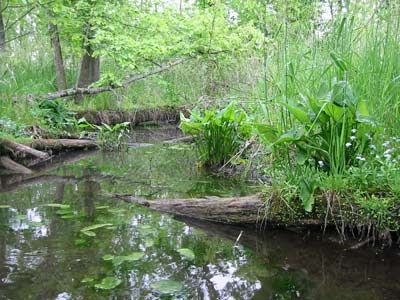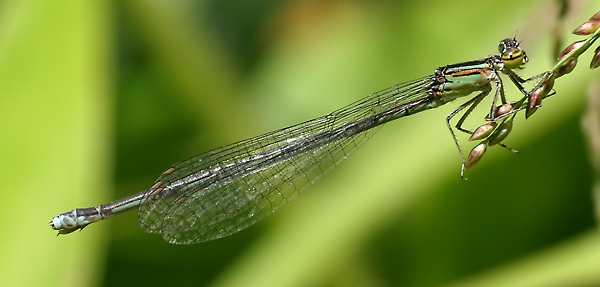Habitat
Nymphs (naiads):
Adult Zygoptera attempt to select habitats that meet as many of the naiads’ requirements as possible. It is impossible for the adults to assess every characteristic of potential sites, but they may rely on aquatic plants to determine macrophyte densities, prey availability, predation risks, and substrate conditions for naiads in littoral areas.
 Naiads thrive in shallow water and weed beds within 20 meters
of the water edge, but they can reside in water as deep as 10.5
meters, though this is rare. Most commonly, naiads live in
stagnant or slowly moving water, including marshes, ponds, and
lakes, but some species have developed adaptations
allowing their naiads to live in fast flowing rivers. To
see determine the flow rate, male naiads may float downstream
for a few seconds; while doing this, the male risks predation,
but he shows off to the girls that he is strong. Tropical
naiads may live in bromeliads which gather rain water; a few
tropical damselfly species have naiads capable of living under
damp leaves.
Naiads thrive in shallow water and weed beds within 20 meters
of the water edge, but they can reside in water as deep as 10.5
meters, though this is rare. Most commonly, naiads live in
stagnant or slowly moving water, including marshes, ponds, and
lakes, but some species have developed adaptations
allowing their naiads to live in fast flowing rivers. To
see determine the flow rate, male naiads may float downstream
for a few seconds; while doing this, the male risks predation,
but he shows off to the girls that he is strong. Tropical
naiads may live in bromeliads which gather rain water; a few
tropical damselfly species have naiads capable of living under
damp leaves.
Damselfly naiads require oxygen-rich water because their
respiratory surfaces
are exposed; this also means
naiads are highly sensitive to poor water quality because they
cannot acquire adequate oxygen in such conditions. Bodies
of water with high plant densities in sunny areas are ideal for
naiads because plants will produce more oxygen during sunny
periods, saturating the aquatic habitat.
Naiads are predators, hunting small, aquatic invertebrates. Zygopteran larvae do not compete with Anisopteran larvae for food because Zygopteran larvae are not capable of overtaking small invertebrates and large insects like the Anisopteran larvae.
Adults:
Like the naiad form, adult Zygoptera habitat areas littoral near marshes, ponds, streams, lakes, and rivers. Once in these areas, damselflies congregate around rigid macrophytes because they provide high perches; such perches benefit them during thermoregulation, mate attraction, and reproduction. As adults emerge from their naiad form, they require these rigid perches where they can safely reside while their wings harden.
Damselflies prefer sunny habitats because they need to bask in the sun before engaging in flight and are rarely active during cloudy days.
 Like their naiads, damselfly adults are predatory organisms.
Adults do not compete with dragonflies for nutrients because the
damselflies are not capable of controlling and overtaking large
prey like the dragonflies can. Damselfly adults hunt small
insects and serve as a food source for birds, fish, dragonflies,
and occasionally other damselflies.
Like their naiads, damselfly adults are predatory organisms.
Adults do not compete with dragonflies for nutrients because the
damselflies are not capable of controlling and overtaking large
prey like the dragonflies can. Damselfly adults hunt small
insects and serve as a food source for birds, fish, dragonflies,
and occasionally other damselflies.
Distribution:
 Damselflies can be found on all continents, excluding
Antarctica, and tend to concentrate in areas with warm, tropical
environments. Even though these are the most common
characteristics for damselfly habitats, some species live in
subtropical wetlands, tropical wet-dry zones, dry forests,
deserts, and ponds with periodic dry spells.
Damselflies can be found on all continents, excluding
Antarctica, and tend to concentrate in areas with warm, tropical
environments. Even though these are the most common
characteristics for damselfly habitats, some species live in
subtropical wetlands, tropical wet-dry zones, dry forests,
deserts, and ponds with periodic dry spells.
They are widely spread in South and Central America and in the Caribbean, but Zygoptera are common in the Andes, the Amazon rainforest, and North America; some damselfly species live in mountainous regions, however, they choose to live at the low and middle elevations. Although species can show habitat preferences, no single species has a well defined global distribution pattern; however, most species remain close to equatorial regions. Prevalent damselfly species are usually the most widespread in the southern hemisphere. Thus far, Lestidae, Calopterygidae, Coenagrionidae, and Protoneuridae are the only Zygoptera families found in North America.
Niche:
Zygoptera populations tend to reside near pond or lake areas
with high macrophyte densities. Damselflies rely on these
aquatic plants for reproduction sites,
ovipositing in or near the macrophytes. Further trophic interactions
can be attributed to increased damselfly densities because
predators will have a wider array of organisms on which to feed;
therefore, when there are large occurrences of damselflies in an
aquatic area, there tends to be higher species diversity among
the fish and birds.
Within a habitat, though, different damselfly species realize
different microhabitats. This often occurs because species
may have prey preferences that cause them to live at a higher or
lower level than other species. It is important for these
deviating species to take predation risks into account too
because by moving out of the original habitat, they risk running
into new predators.
Hopefully damselflies live near you! Continue on to learn how they have adapted to these habitats.
